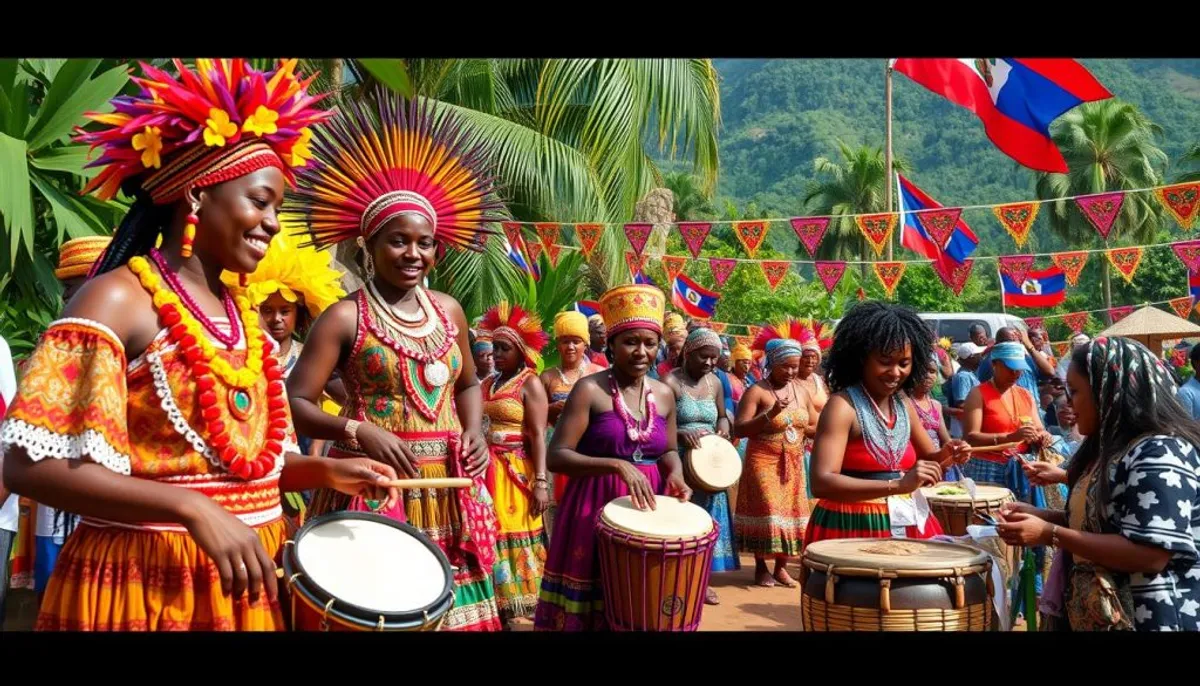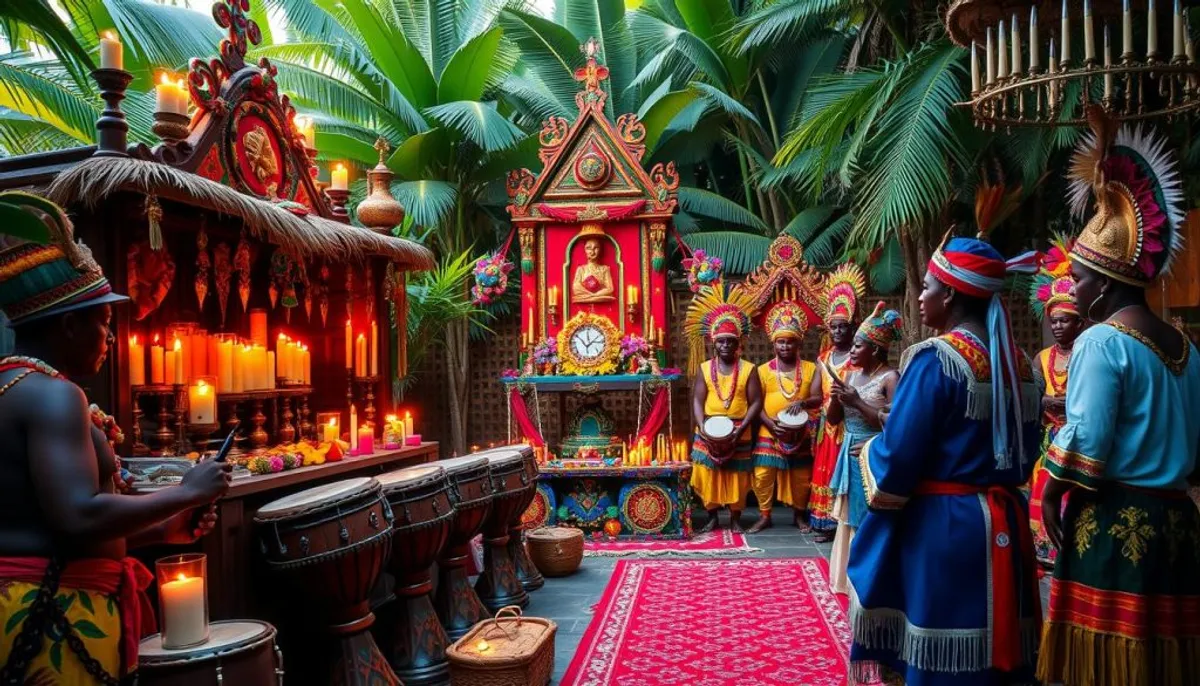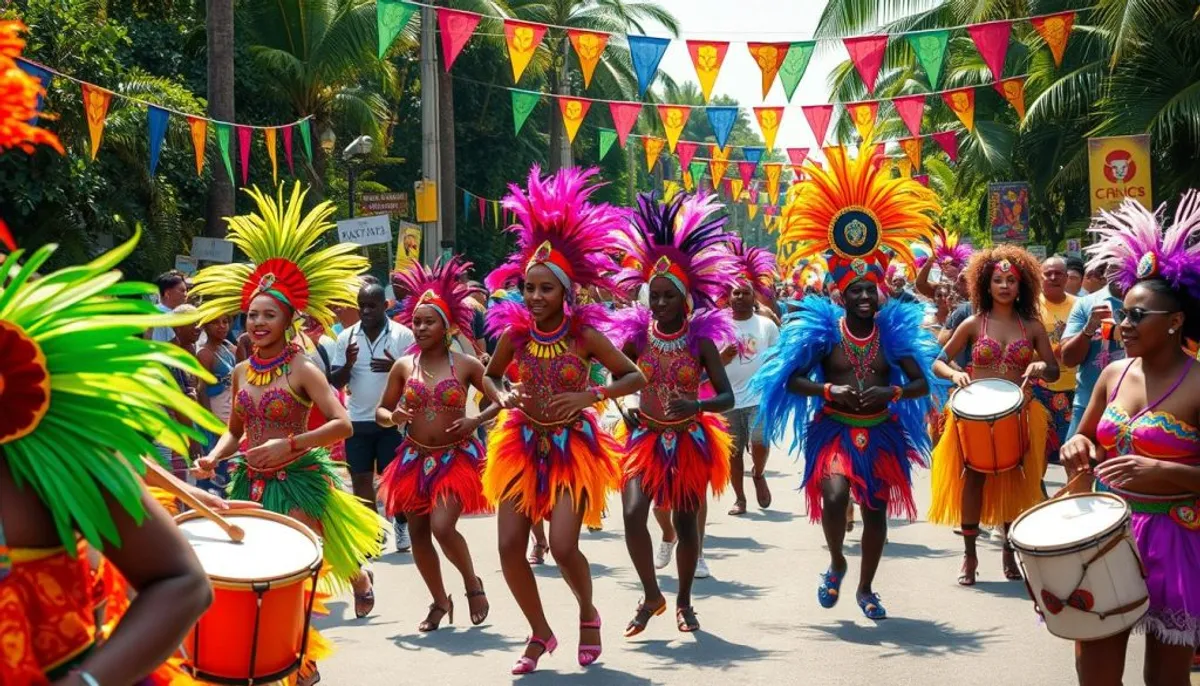Haiti, a pearl of the Caribbean, stands out for its rich and vibrant culture. This Caribbean country is a fascinating blend of African and European traditions. Haitian culture, shaped by its tumultuous history, is characterized by its resilience and creativity.

The Haitian heritage manifests in all aspects of daily life. From tasty dishes like griot and joumou to colorful celebrations of Carnival, each element tells a story. Rara music and Vodou practices add a unique spiritual dimension to this dynamic culture.
Haitian traditions, rooted in solidarity, are reflected in the concept of Konbit. This practice of collective labor strengthens community ties. Traditional games, such as lido and yoyo, perpetuate the playful spirit across generations.
Haiti, proud of its independence gained in 1804, continues to celebrate its heritage. French and Haitian Creole, the official languages, testify to the country's linguistic diversity. The motto “L'Union Fait La Force” perfectly illustrates the essence of Haitian culture: united in its diversity.
What is Haitian culture: origins and influences
Haitian culture is a fascinating mix of diverse cultural origins. It draws its roots from a rich African and Caribbean heritage, influenced by a complex colonial history. This unique syncretism has created a vibrant and distinct cultural identity.
The African and Caribbean heritage
African influences are deeply embedded in Haitian culture. They manifest in spirituality, music, and oral traditions. The Caribbean heritage enriches the cuisine, offering a fusion of unique flavors. Haitian literature, primarily in French, includes authors such as Jean Price Mars and Jacques Roumain.
The unique cultural syncretism
The cultural syncretism of Haiti has given rise to unique practices. Vodou, a fusion of Catholicism and African beliefs, is central to Haitian traditions. Haitian painting, with artists like Préfète Duffaut, is distinguished by its exuberant style. The varied craftsmanship, including wooden sculptures and Jacmel carnival masks, reflects this diversity.
The impact of colonial history
The colonial history has profoundly marked Haiti, influencing its language and traditions. Haitian Creole, spoken by 98% of the population, is a testament to this past. Haitian music, with genres like compas and raboday, reflects this rich history. The Haitian carnival, a popular cultural celebration, is another example of the transformed colonial heritage.
| Cultural Aspect | Main Influence | Example |
|---|---|---|
| Language | Colonial history | Haitian Creole |
| Spirituality | Syncretism | Vodou |
| Music | African heritage | Compas |
| Cuisine | Caribbean influences | Fusion of flavors |
The spiritual and religious traditions of Haiti
Haitian spirituality presents itself as a complex fabric, intertwining various beliefs and practices. Haitian Vodou, established as an official religion in 2003, holds a prominent place in this cultural richness.
Vodou: spirituality and ritual practices
Haitian Vodou is inspired by African traditions, notably Yoruba, Fon, and Ewe. This religious syncretism, emerging in the 18th century, fused Catholic and indigenous elements. Practitioners, known as “vaudouisants,” honor a pantheon of loas, including Papa Legba, Erzulie Freda, and Simbi.

The ceremonies and religious festivals
Vodou rituals are imbued with deep symbolism. The veve, drawn on the ground, serve as a bridge for communication with spirits. Music and dance, essential, unite the community in prayer. These ceremonies are moments of healing and emotional support, strengthening community bonds.
The Fèt Gede: communion with ancestors
The Fèt Gede, celebrated on November 1st and 2nd, honors the dead. This festival highlights the deep connection between the living and their ancestors. It is a moment of reflection, celebration, and respect for those who have crossed over.
| Religious Aspect | Percentage of the population |
|---|---|
| Protestants | 53% |
| Catholics | 35% |
| Vodou (declared) | 1-3% |
Even though Vodou is officially practiced by a minority, its influence transcends statistics. It deeply permeates Haitian culture and identity.
The living cultural heritage
The Haitian cultural heritage presents itself as a living treasure, embodied in various artistic forms. Haitian music plays a predominant role in daily life, with captivating rhythms such as Kompa, Twoubadou, and zouk. These unique rhythms reflect the essence of the Haitian people and their deep history.
Haitian art flourishes in colorful streets and creative workshops. The Jacmel carnival, declared a national festival, showcases the talent of local artisans. Their creations, ranging from masks to costumes, demonstrate limitless imagination and ancestral craftsmanship.

Haitian literature significantly enriches the country's heritage. Writers like Jacques Roumain, René Depestre, and Dany Laferrière have influenced Francophone literature. Their works delve into Haitian identity, the complex history of the country, and current challenges.
| Cultural Element | Description | Importance |
|---|---|---|
| Music | Kompa, Twoubadou, Zouk | Expression of national identity |
| Carnival | Annual festival in Jacmel | Showcase of artisanal talent |
| Literature | Works in French and Creole | Reflection on history and society |
Folktales, passed down orally, are an essential element of this living heritage. They convey ancestral wisdom and enrich the collective imagination. This oral tradition is a foundation of Haitian culture, linking the past to the present.
Community life and social practices
Haitian culture is distinguished by its rich community life and unique social practices. Large families, often living together, create a strong sense of unity and belonging. This solidarity is reflected in lively markets, dynamic religious ceremonies, and the omnipresence of music, notably kompa and rara.
The Konbit: solidarity and collective work
The Konbit, a pillar of Haitian community solidarity, perfectly illustrates the spirit of cooperation. This ancestral practice brings villagers together for collective work, strengthening social ties and boosting the local economy. In rural areas, the Konbit plays a crucial role in agriculture and craftsmanship, promoting the sharing of resources and knowledge.
The Lakou system: traditional social organization
The Lakou, a form of traditional social organization, offers a communal space conducive to education and sharing. This system reinforces social practices and perpetuates Haitian cultural values. The streets adorned with murals and colorful sculptures testify to the pride of Haitians in their heritage, while the École de L'Artibonite, a prestigious artistic institution, contributes to the preservation of these traditions.
Traditional Haitian games
Traditional Haitian games hold an important place in social life. Lido, sote kòd, and woule sèk are activities that bring generations together and strengthen community cohesion. These playful practices, rooted in Haitian culture, contribute to the transmission of values and the maintenance of a strong social fabric, even within the diaspora that remains deeply attached to its cultural identity.
RelatedRelated articles


